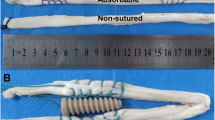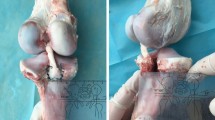Abstract
This biomechanical study compares the initial fixation strength of a novel bioabsorbable two-shell expansion bolt (EB) with that of a well-established interference-screw technique in bone–patellar tendon–bone (BPTB) reconstruction in a calf model. Thirty tibia plateaus (age 5–6 months) were assigned to three groups: In groups I and II, trapezoidal bone plugs of BPTB grafts were fixed with bioabsorbable poly-L-lactide interference screws (8×23 mm) or titanium interference screws (8×25 mm) respectively. In group III, semicircular grafts were fixed using bioabsorbable poly-D, L-lactide expansion bolts (5.8/8.7×10×35 mm). The tensile axis was parallel to the bone tunnel, and the construction was loaded until failure applying a displacement rate of 1 mm per second. In group II the mean ultimate loads to failure (713 N±218 N) were found to be significantly higher than those of groups I (487 N±205 N) and III (510 N±133 N). Measurement of stiffness showed 45 N/mm±13.3 in group I, 58 N/mm±17.4 in group II and 46 N/mm±6.9 in group III, and did not demonstrate significant differences. We found a correlation between insertion torque and wedge insertion force and ultimate loads to failure in all groups ( r =0.53 in group I, r =0.54 in group II, and r =0.57 in group III). Cross-section planes of bone tunnel increased by 51%, 30% and 31% respectively, following insertion of screws or expansion of bolts ( p <0.05). We conclude that ACL graft fixation by means of the presented expansion bolt demonstrates a fixation strength similar to the established bioabsorbable screw fixation, and is a reasonable alternative fixation method, especially since some of the specific pitfalls of screw fixation can be avoided.







Similar content being viewed by others
References
Abate JA, Fadale PD, Hulstyn MJ, Walsh WR (1998) Initial fixation strength of polylactic acid interference screws in anterior cruciate ligament reconstruction. Arthroscopy 14:278–284
Bach BR (1989) Potential pitfalls of Kurosaka screw interference fixation for ACL surgery. Am J Knee Surg 2:76–82
Barber FA, Elrod BF, McGuire DA, Paulos LE (1995) Preliminary results of an absorbable interference screw. Arthroscopy 11:537–548
Benson ER, Barnett PR (1998) A delayed transverse avulsion fracture of the superior pole of the patella after anterior cruciate ligament reconstruction. Arthroscopy 14:85–88
Boszotta H, Anderl W (2001) Primary stability with tibial press-fit fixation of patellar ligament graft: An experimental study in ovine knees. Arthroscopy 17:963–970
Brodie JT, Torpey BM, Donald GD 3rd, Bade HA 3rd (1996) Femoral interference screw placement through the tibial tunnel: a radiographic evaluation of interference screw divergence angles after endoscopic anterior cruciate ligament reconstruction. Arthroscopy 12:435–440
Brown CH, Carson EW (1999) Revision anterior cruciate ligament surgery. Clin Sports Med 18:109–171
Brown CH, Hecker AT, Hipp JA, Myers ER, Hayes WC (1993) The biomechanics of interference screw fixation of patellar-tendon anterior cruciate ligament grafts. Am J Sports Med 21:880–886.
Brown GA, Pena F, Grontvedt T, Labadie D, Engebretsen L (1996) Fixation strength of interference-screw fixation in bovine, young human, and elderly human cadaver knees: influence of insertion torque, tunnel–bone block gap, and interference. Knee Surg Sports Traumatol Arthrosc 3:238–244
Brownstein B, Bronner S (1997) Patella fractures associated with accelerated ACL rehabilitation in patients with autogenous patella tendon reconstructions. J Orthop Sports Phys Ther 26:168–172
Frank CB, Jackson DW (1997) The science of reconstruction of the anterior cruciate ligament. J Bone Joint Surg Am 79:1556–1576
Getelman MH, Friedman MJ (1999) Revision anterior cruciate ligament reconstruction surgery. J Am Acad Orthop Surg 7:189–198
Hackl W, Benedetto KP, Hoser C, Künzel KH, Fink C (2000) Is screw divergence in femoral bone–tendon–bone graft fixation avoidable in anterior cruciate ligament reconstruction using a single-incision technique? A radiographically-controlled cadaver study. Arthroscopy 16:640–647
Hackl W, Fink C, Benedetto KP, Hoser C (2000) Transplantatfixation bei der vorderen Kreuzbandrekonstruktion: Metall- vs bioresorbierbare Polyglykonat-Interferenzschraube—Eine prospektiverandomisierte Studie von 40 Patienten [Transplant fixation by anterior cruciate ligament reconstruction. Metal vs bioabsorbable polyglyconate interference screw. A prospective randomized study of 40 patients]. Unfallchirurg 103:468–474
Hoffmann RF, Peine R, Bail HJ, Südkamp NP, Weiler A (1999) Initial fixation strength of modified patellar tendon grafts for anatomic fixation in anterior cruciate ligament reconstruction. Arthroscopy 15:392–399
Hulstyn M, Fadale PD, Abate J, Walsh WR (1993) Biomechanical evaluation of interference screw fixation in a bovine patellar bone–tendon–bone autograft complex for anterior cruciate ligament reconstruction. Arthroscopy 9:417–424
Johnson LL, van Dyk GE (1994) Arthroscopically-monitored ACL reconstruction: compaction drilling and compression screw. In: Feagin JAJ (ed) The crucial ligaments: diagnosis and treatment of ligamentous injuries about the knee, 2nd edn. Churchill Livingstone, New York, pp 555–593
Jomha NM, Raso VJ, Leung P (1993) Effect of varying angles on the pullout strength of interference screw fixation. Arthroscopy 9:580–583
Kohn D, Rose C (1994) Primary stability of interference screw fixation. Influence of screw diameter and insertion torque. Am J Sports Med 22:334–338
Kousa P, Järvinen TL, Kannus P, Ahvenjärvi P, Kaikkonen A, Järvinen M (2001) A bioabsorbable plug in bone–tendon–bone reconstruction of the anterior cruciate ligament: introduction of a novel fixation technique. Arthroscopy 17:144–150
Kousa P, Järvinen TL, Pohjonen T, Kannus P, Kotikoski M, Järvinen M (1995) Fixation strength of a biodegradable screw in anterior cruciate ligament reconstruction. J Bone Joint Surg Br 77:901–905
Lemos MJ, Albert J, Simon T, Jackson DW (1993) Radiographic analysis of femoral interference-screw placement during ACL reconstruction: endoscopic versus open technique. Arthroscopy 9:154–158
Magen HE, Howell SM, Hull ML (1999) Structural properties of six tibial fixation methods for anterior cruciate ligament soft tissue grafts. Am J Sports Med 27:35–43
Markolf KL, Burchfield DM, Shapiro MM, Cha CW, Finerman GA, Slauterbeck JL (1996) Biomechanical consequences of replacement of the anterior cruciate ligament with a patellar ligament allograft. Part II: forces in the graft compared with forces in the intact ligament. J Bone Joint Surg Am 78:1728–1734
Marti C, Imhoff AB, Bahrs C, Romero J (1997) Metallic versus bioabsorbable interference screw for fixation of bone–patellar tendon–bone autograft in arthroscopic anterior cruciate ligament reconstruction. A preliminary report. Knee Surg Sports Traumatol Arthrosc 5:217–221
Matthews LS, Soffer SR (1989) Pitfalls in the use of interference screws for anterior cruciate ligament reconstruction: brief report. Arthroscopy 5:225–226
Noyes FR, Butler DL, Grood ES, Zernicke RF, Hefzy MS (1984) Biomechanical analysis of human ligament grafts used in knee-ligament repairs and reconstructions. J Bone Joint Surg Am 66:344–352
Papageorgiou CD, Kostopoulos VK, Moebius UG, Petropoulou KA, Georgoulis AD, Soucacos PN (2001) Patellar fractures associated with medial-third bone–patellar tendon–bone autograft ACL reconstruction. Knee Surg Sports Traumatol Arthrosc 9:151–154
Pena F, Grontvedt T, Brown GA, Aune AK, Engebretsen L (1996) Comparison of failure strength between metallic and absorbable interference screws. Influence of insertion torque, tunnel–bone block gap, bone mineral density, and interference. Am J Sports Med 24:329–334
Pierz K, Baltz M, Fulkerson J (1995) The effect of Kurosaka screw divergence on the holding strength of bone–tendon–bone grafts. Am J Sports Med 23:332–335
Rahn BA (1987) Direct and indirect bone healing after operative fracture treatment. Otolaryngol Clin North Am 20:425–440
Rupp S, Hopf T, Hess T, Seil R, Kohn DM (1999) Resulting tensile forces in the human bone–patellar tendon–bone graft: direct force measurement in vitro. Arthroscopy 15:179–184
Rupp S, Kaltenkirchen N, Hopf T, Gleitz M (1995) Klinische Relevanz von Bohrkanalposition und Interferenzschraubenlage nach Ersatzplastik des vorderen Kreuzbandes mit Ligamentum-patellae-Transplantat [Clinical relevance of tunnel position and interference screw location after replacement-plasty of the anterior cruciate ligament with a patellar ligament transplant]. Unfallchirurg 98:650–654
Rupp S, Seil R, Krauss PW, Kohn DM (1998) Cortical versus cancellous interference fixation for bone–patellar tendon–bone grafts. Arthroscopy 14:484–488
Safran MR, Harner CD (1996) Technical considerations of revision anterior cruciate ligament surgery. Clin Orthop 325:50–64
Scheffler SU, Südkamp NP, Göckenjan A, Hoffmann RF, Weiler A (2002) Biomechanical comparison of hamstring and patellar tendon graft anterior cruciate ligament reconstruction techniques: The impact of fixation level and fixation method under cyclic loading. Arthroscopy 18:304–315
Schroeder FJ (1999) Reduction of femoral interference-screw divergence during endoscopic anterior cruciate ligament reconstruction. Arthroscopy 15:41–48
Seil R, Rupp S, Krauss PW, Benz A, Kohn DM (1998) Comparison of initial fixation strength between biodegradable and metallic interference screws and a press-fit fixation technique in a porcine model. Am J Sports Med 26:815–819
Shapiro JD, Cohn BT, Jackson DW, Postak PD, Parker RD, Greenwald AS (1992) The biomechanical effects of geometric configuration of bone–tendon–bone autografts in anterior cruciate ligament reconstruction. Arthroscopy 8:453–458
Shapiro JD, Jackson DW, Aberman HM, Lee TQ, Simon TM (1995) Comparison of pullout strength for seven- and nine-millimeter diameter interference-screw size as used in anterior cruciate ligament reconstruction. Arthroscopy 11:596–599
Shelbourne KD, Nitz P (1990) Accelerated rehabilitation after anterior cruciate ligament reconstruction. Am J Sports Med 18:292–299
Shellock FG, Mink JH, Curtin S, Friedman MJ (1992) MR imaging and metallic implants for anterior cruciate ligament reconstruction: assessment of ferromagnetism and artifact. J Magn Reson Imaging 2:225–228
Stadelmaier DM, Lowe WR, Ilahi OA, Noble PC, Kohl HW (1999) Cyclic pull-out strength of hamstring tendon graft fixation with soft-tissue interference screws. Influence of screw length. Am J Sports Med 27:778–783
Suh JS, Jeong EK, Shin KH, Cho JH, Na JB, Kim DH, Han CD (1998) Minimizing artifacts caused by metallic implants at MR imaging: experimental and clinical studies. AJR Am J Roentgenol 171:1207–1213
Tomita F, Yasuda K, Mikami S, Sakai T, Yamazaki S, Tohyama H (2001) Comparisons of intraosseous graft healing between the doubled flexor tendon graft and the bone–patellar tendon–bone graft in anterior cruciate ligament reconstruction. Arthroscopy 17:461–476
Tuompo P, Partio EK, Jukkala-Partio K, Pohjonen T, Helevirta P, Rokkanen P (1996) Strength of the fixation of patellar tendon bone grafts using a totally absorbable self-reinforced poly-L-lactide expansion plug and screw. An experimental study in a bovine cadaver. Arthroscopy 12:422–427
Tuompo P, Partio EK, Jukkala-Partio K, Pohjonen T, Helevirta P, Rokkanen P (1999) Comparison of polylactide screw and expansion bolt in bioabsorbable fixation with patellar tendon bone graft for anterior cruciate ligament rupture of the knee. A preliminary study. Knee Surg Sports Traumatol Arthrosc 7:296–302
Walton M (1999) Absorbable and metal interference screws: comparison of graft security during healing. Arthroscopy 15:818–826
Weiler A, Hoffmann RF, Bail HJ, Rehm O, Südkamp NP (2002) Tendon healing in a bone tunnel. Part II: Histologic analysis after biodegradable interference fit fixation in a model of anterior cruciate ligament reconstruction in sheep. Arthroscopy 18:124–135
Weiler A, Hoffmann RF, Südkamp NP, Siepe CJ, Haas NP (1999) Ersatz des vorderen Kreuzbandes: Biomechanische Untersuchungen zur Patellar- und Semitendinosussehnenverankerung mit einer Poly- (D,L-Laktid)-Interferenzschraube [Replacement of the anterior cruciate ligament. Biomechanical studies for patellar and semitendinosus tendon fixation with a poly (D,L-lactide) interference screw]. Unfallchirurg 102:115–123
Weiler A, Windhagen HJ, Raschke MJ, Laumeyer A, Hoffmann RF (1998) Biodegradable interference screw fixation exhibits pull-out force and stiffness similar to titanium screws. Am J Sports Med 26:119–126
Acknowledgements
The authors thank Arthrex Inc., Naples, FL, USA and A.M.I. GmbH, Goetzis, Austria, for providing us with the test implants. We gratefully acknowledge the help of H. Bonel M.D. and H. Hildebrandt from the Department of Diagnostic Radiology, for their valuable support with CT measurements. The paper was partially presented at the 21st Annual Meeting of the Arthroscopy Association of North America, 25–28 April 2002, Washington, DC. This work has been sponsored by funds of the University of Munich and the board of editors of the Münchner Medizinische Wochenschrift.
Author information
Authors and Affiliations
Corresponding author
Rights and permissions
About this article
Cite this article
Piltz, S., Strunk, P., Meyer, L. et al. Fixation strength of a novel bioabsorbable expansion bolt for patellar tendon bone graft fixation: an experimental study in calf tibial bone. Knee Surg Sports Traumatol Arthrosc 12, 376–383 (2004). https://doi.org/10.1007/s00167-003-0463-7
Received:
Accepted:
Published:
Issue Date:
DOI: https://doi.org/10.1007/s00167-003-0463-7




